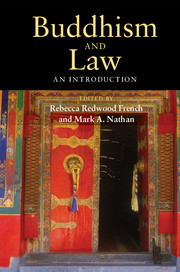Book contents
- Frontmatter
- Dedication
- Contents
- Maps and Illustrations
- Contributors
- Preface
- Abbreviations
- Introducing Buddhism and Law
- Part I The Roots of Buddhism and Law in India
- Part II Buddhism and Law in South and Southeast Asia
- 6 Buddhism and Law in Sri Lanka
- 7 Flanked by Images of Our Buddha
- 8 The Legal Regulation of Buddhism in Contemporary Sri Lanka
- 9 Pāli Buddhist Law in Southeast Asia
- 10 Genres and Jurisdictions
- Part III Buddhism and Law in East Asia
- Part IV Buddhism and Law in North Asia and the Himalayan Region
- A Selection of Readings
- Index
- References
7 - Flanked by Images of Our Buddha
Community, Law, and Religion in a Premodern Buddhist Context
Published online by Cambridge University Press: 05 August 2014
- Frontmatter
- Dedication
- Contents
- Maps and Illustrations
- Contributors
- Preface
- Abbreviations
- Introducing Buddhism and Law
- Part I The Roots of Buddhism and Law in India
- Part II Buddhism and Law in South and Southeast Asia
- 6 Buddhism and Law in Sri Lanka
- 7 Flanked by Images of Our Buddha
- 8 The Legal Regulation of Buddhism in Contemporary Sri Lanka
- 9 Pāli Buddhist Law in Southeast Asia
- 10 Genres and Jurisdictions
- Part III Buddhism and Law in East Asia
- Part IV Buddhism and Law in North Asia and the Himalayan Region
- A Selection of Readings
- Index
- References
Summary
Introduction
This chapter explicates an act of monastic regulation recorded in stone by a powerful Sri Lankan Buddhist king, Parākramabāhu I (1153–86). Stone inscriptions like this one (and parallel incised metal and palm-leaf texts) exemplified the shared form of legal declarations throughout premodern Sri Lanka and much of South Asia. They typically open with an invocation championing the political legitimacy and religious outlook of the responsible monarch or other official, proceed with an operative portion detailing the background and specific political-legal act each concerns, and conclude with an enforcement clause, and aspiration for success. Thousands of such documents still exist today as a major source for the study of premodern South Asian law.
In form, King Parākramabāhu I’s inscription is typical of such documents. It invokes the king’s royal splendor and Buddhist ideology, proceeds with the regulations themselves, and concludes with enforcement clauses (although not, in this record, a final aspiration). Yet this was not just any inscription. As detailed below, this inscription enacted momentous changes in the Sri Lankan religious community of Parākramabāhu’s day and gave birth to a regulatory genre that lasted for hundreds of years. The inscription broadcasts its own significance: It is incised on a 13ʹ 3ʹʹ × 9ʹ 9ʹʹ rectangular rock face in the center of Parākramabāhu’s most famous monument, called Gal Vihāra (“Rock Monastery”), flanked on either side by colossal Buddha images exquisitely carved from a single rock outcropping fifty-six meters long.
- Type
- Chapter
- Information
- Buddhism and LawAn Introduction, pp. 135 - 149Publisher: Cambridge University PressPrint publication year: 2014
References
- 1
- Cited by



